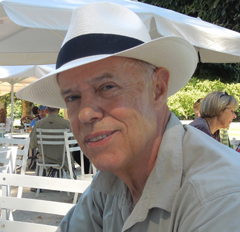|
 Roger del Moral Roger del Moral
Professor Emeritus of Biology
Dr. del Moral received his doctorate with C. H. Muller at the University of
California, Santa Barbara, in 1968 and immediately joined the faculty at the University of Washington. Here he began a series of
studies of vegetation patterns in forests and alpine sites of the Wenatchee Mountains, Alpine Lakes and Olympic Peninsula. In 1976-1977, he spent a year in Australia at the CSIRO in Queensland, where he learned about vegetation analysis, and at Melbourne
University. Here, with David Ashton, he was the first to demonstrate that Eucalyptus
inhibited native Australian shrubs in natural coastal heath. His pioneering work on plant
competition in stable alpine habitats was interrupted by the 1980 eruption
of Mount St. Helens. He was among the first ecologists to begin study of
the recovery of this volcano, studies which have produced one of the
longest continuous records of primary succession now extant and have resulted in over 70 papers. In 1984, he
worked on reclamation of derelict sites in the U.K. (with A. D. Bradshaw), while in 1985 he was introduced to a wide
variety of Japanese volcanoes including Fuji-san and Sakurajima.
He has explored several volcanoes in the Russian Far East (Sergei Grishin), in
Sicily (Emilia Poli Marchese) during his Sabbatical (2001), in Iceland
(Hekla and Surtsey) with Borgthor Magnusson and in New Zealand. In 2007, he published Environmental
disasters, natural recovery and human responses, a general book on restoring the landscape using
the lessons gained from nature.
Research Interests
Dr. del Moral has studied and described vegetation structure in forests,
prairies, wetlands and meadows throughout Washington. He has conducted large scale vegetation surveys, mapped the Alpine Lakes Wilderness and
studied factors that control community structure in stable communities. Since 1980, his work has centered on primary succession and its
relationship to restoration. Most of this work has explored the mechanisms
of vegetation recovery on Mount St. Helens, but he has conducted research
on several other volcanoes. A
series of papers have combined long-term plot records, focused field
experiments and laboratory trials to explore mechanisms of primary
succession. Several bits of "conventional wisdom" have been
modified or shown to be overly simple. Stochastic processes are very
important during early succession and landscape effects, more than any
other factor, dictate the nature of early species assemblages. In contrast
to prevailing theory, abiotic amelioration is much more important that
biotic facilitation, physical safe-sites are initially more important than
nurse plant effects, refugia contribute little to the development of their
surroundings, and mycorrhizae play a very limited role on volcanic
succession. His studies in Japan, the Russian Far East and Surtsey (Iceland) have shown that
similar processes have controlled succession on volcanoes in these regions.
With Lars Walker of UNLV, he completed a book on the current concepts of primary succession that
summarizes the historical and developing concepts surrounding how
landscapes are recolonized after devastating disturbances. Widely
recognized as a major synthesis of the state of knowledge in primary
succession, Primary Succession and Ecological Rehabilitation has won praise from ecologists
and restorationists alike.
In 2007, he published a second book Ecological responses to natural disasters
that was intended for a more general public. He and Lawrence Walker hope that this book stimulates a
wider knowledge of ecological principles in the service of great quality of life. This book emerged, in part, from his strong interests in restoration ecology and built on his practical experience as a wetland consultant.
In 2014, after 45 years at the University of Washington, he retired from teaching, but he continues to explore succession and natural habitats.
Mount St. Helens Memoir
Professor del Moral created the longest continuous record of vegetation recovery on a new volcanic surface.
His Mount St. Helens succession study described the first 32 years of change on this mountain and led to
collaborations with scientists studying volcanoes in Iceland, Italy, Russia, Japan, the Philippines and elsewhere.
He prepared a memoir providing a personal account of ecosystem recovery after volcanic eruptions.
In this memoir, he provides an account of major volcanic eruptions and their historical importance.
These massive events include Thera, which devastated the Minoan civilization, Laki, whose 1783 eruption may have precipitated the French Revolution and 1883 Krakatau eruption.
He describes how research in many habitats describing the mechanisms of the recovery on Mount St. Helens has expanded understanding of ecosystems recovery.
This memoir includes personal reflections of special times and special people. The work of many ecologists in multiple habitats is reviewed, but the focus is on
the findings of his research team.
The first section describes the range of volcanic impacts. The five chapters discuss tephra, blown-down forests, lahars, severely impacted sites and pyroclastic deposits.
The second section explores successional mechanisms and advances in ecological theory.
Chapters describe the importance of dispersal, how plants establish, patterns of development and mechanisms of vegetation maturation.
A summary chapter explores how studies of Mount St. Helens have altered ecological theory.
The final section describes the life histories and ecological attributes of most of the common plants found these successional habitats.
The memoir is well illustrated with images documenting the aftermath of the eruption, of the evolving landscapes and of many of the plant species found. High resolution images are available.
Below are links to PDFs of each of the chapters. The Vegetation Recovery of
Mount St. Helens: a personal view of successional process.
|